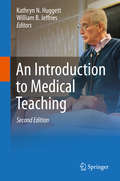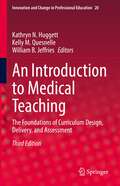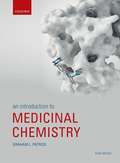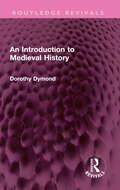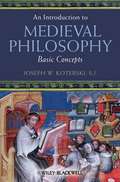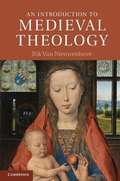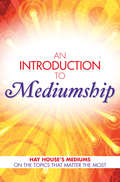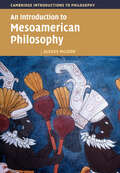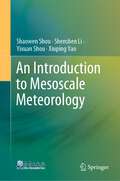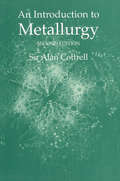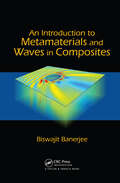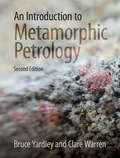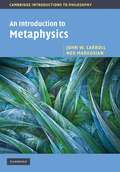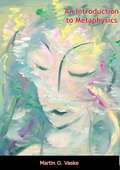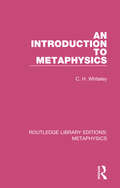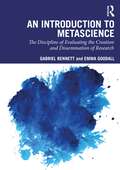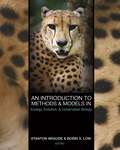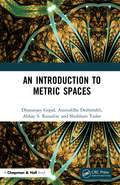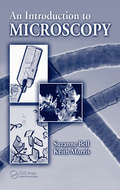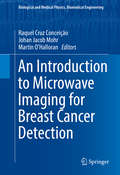- Table View
- List View
An Introduction to Medical Teaching
by William B. Jeffries Kathryn N. HuggettFew faculty members in academic medical centers are formally prepared for their roles as teachers. This work is an introductory text designed to provide medical teachers with the core concepts of effective teaching practice and information about innovations for curriculum design, delivery and assessment. It offers brief, focused chapters with content that is assimilated easily by the reader. The topics are relevant to basic science and clinical teachers and the work does not presume readers possess prerequisite knowledge of education theory or instructional design. The authors emphasize the application of concepts to teaching practice. Topics include: Facilitating Student Learning; Teaching Large Groups; Teaching in Small Groups; Flipping the Classroom; Problem-Based Learning; Team-Based Learning; Teaching Clinical Skills; Teaching with Simulation; Teaching with Practicals and Labs; Teaching with Technological Tools; Teaching to Develop Scientific Engagement in Medical Students; Designing a Course; Establishing and Teaching Elective Courses; Designing Global Health Experiences; Assessing Student Performance; Documenting the Trajectory of Your Teaching and Teaching as Scholarship. This is a complete revision of the first edition of this work with new chapters and up to date information. Similar to the first edition, chapters were written by leaders in medical education and research who draw upon extensive professional experience and the literature on best practices in education. Although designed for teachers, the work reflects a learner-centered perspective and emphasizes outcomes for student learning. The book is accessible and visually interesting and the work contains information that is current, but not time-sensitive. Each chapter concludes with references, many include recommendations for additional reading, and the work includes an appendix with resources for medical education.
An Introduction to Medical Teaching: The Foundations of Curriculum Design, Delivery, and Assessment (Innovation and Change in Professional Education #20)
by William B. Jeffries Kathryn N. Huggett Kelly M. QuesnelleThis is an introductory text designed to provide medical teachers with a comprehensive introduction to the core concepts of effective teaching practice. It contains introductory-level information about innovations for curriculum design, delivery, and assessment, all in a singular text. The work offers brief, focused chapters with content that can be easily assimilated by the reader. The topics are relevant to basic science and clinical teachers, and the work does not presume readers possess prerequisite knowledge of education theory or instructional design.The book builds upon and extends the content of the second edition by incorporating additional content to reflect advances in cognitive science and by updating existing chapters to keep pace with modern educational trends and technologies.
An Introduction to Medicinal Chemistry
by Graham PatrickFor many people, taking some form of medication is part of everyday life, whether for mild or severe illness, acute or chronic disease, to target infection or to relieve pain. However for most it remains a mystery as to what happens once the drug has been taken into the body: how do the drugs actually work? Furthermore, by what processes are new drugs discovered and brought to market? <P><P>An Introduction to Medicinal Chemistry, sixth edition, provides an accessible and comprehensive account of this fascinating multidisciplinary field. Assuming little prior knowledge, the text is ideal for those studying the subject for the first time. Part one of the book introduces the principles of drug action via targets such as receptors and enzymes. The book goes on to explore how drugs work at the molecular level (pharmacodynamics), and the processes involved in ensuring a drug meets its target (pharmacokinetics). Further sections cover the processes by which drugs are discovered and designed, and what has to happen before a drug can be made available to the public. The book concludes with a selection of current topics in medicinal chemistry, and a discussion of various key drug groups. The subject is brought to life throughout by engaging case studies highlighting particular drugs and the stories behind their discovery and development. <P><P>The Online Resource Centre features: <P><P>For students: <br>DT Multiple Choice Questions to support self-directed learning <br>DT Web articles describing recent developments in the field and further information on topics covered in the book <br>DT Journal Club to encourage students to critically analyse the research literature <br>DT Molecular Modelling Exercises, with new exercises in Chem3D <br>DT New assignments to help students develop data analysis and problem solving skills <P><P>For registered adopters of the book: <br>DT A test bank of additional multiple-choice questions, with links to relevant sections in the book <br>DT Answers to end-of-chapter questions. <br>DT Figures from the book, ready to download. <br>DT Power Point slides to accompany every chapter in the book.
An Introduction to Medieval History (Routledge Revivals)
by Dorothy DymondFirst Published in 1929 An Introduction to Medieval History presents a comprehensive overview of the social, political, and religious movements that inspired medieval civilization and still influence the civilization of our own day. It brings crucial themes like the heritage of Rome; church and the Empire; the peasant and his Lord; nations and kings; empire and papacy; the eastern empire and the Crusades; transition to modern times; decline of empire and papacy; decline of feudalism and development of trade; and towns and the Renaissance. This introductory book is useful for history students in secondary schools and training colleges and general readers interested to know about the medieval times.
An Introduction to Medieval Philosophy: Basic Concepts
by Joseph W. KoterskiBy exploring the philosophical character of some of the greatest medieval thinkers, An Introduction to Medieval Philosophy provides a rich overview of philosophy in the world of Latin Christianity. Explores the deeply philosophical character of such medieval thinkers as Augustine, Boethius, Eriugena, Anselm, Aquinas, Bonaventure, Scotus, and Ockham Reviews the central features of the epistemological and metaphysical problem of universals Shows how medieval authors adapted philosophical ideas from antiquity to apply to their religious commitments Takes a broad philosophical approach of the medieval era by,taking account of classical metaphysics, general culture, and religious themes
An Introduction to Medieval Theology
by Rik Van NieuwenhoveMedieval theology, in all its diversity, was radically theo-centric, Trinitarian, Scriptural and sacramental. It also operated with a profound view of human understanding (in terms of intellectus rather than mere ratio). In a post-modern climate, in which the modern views on 'autonomous reason' are increasingly being questioned, it may prove fruitful to re-engage with pre-modern thinkers who, obviously, did not share our modern and post-modern presuppositions. Their different perspective does not antiquate their thought, as some of the 'cultured despisers' of medieval thought might imagine. On the contrary, rather than rendering their views obsolete it makes them profoundly challenging and enriching for theology today. This book is more than a survey of key medieval thinkers (from Augustine to the late-medieval period); it is an invitation to think along with major theologians and explore how their thought can deeply challenge some of today's modern and post-modern key assumptions.
An Introduction to Mediumship: Hay House Mediums on the Topics that Matter Most
by John Holland Gordon SmithHay House’s mediums will show you how to improve a host of skills with this free guide.An Introduction to Mediumship discusses:• What ghosts are, and why they come back – Gordon Smith• How to find a medium – Heidi Sawyer• Reincarnation – Lisa Williams• How to find your spirit guide – Sylvia Browne• Signs from Heaven – John Holland
An Introduction to Mental Health
by Briony Williams Justine Bold Jo Augustus"A well-written resource providing up-to-date research and important examples of application to practice. Using a strong evidence-base, the book offers a variety of perspectives which speak to the challenges faced by managers, policy makers, patients, service users and carers." - Vanessa Evans, Foundation Degree in Mental Health Lead, Coleg Gwent An Introduction to Mental Health is essential reading for anyone learning the fundamentals of mental health. Written for an interdisciplinary audience with a patient-centred focus, it covers historical context through to contemporary issues, including mental health as it relates to the law and to policy. Key learning features include concept summaries, reflective points, case studies and reflective exercises to help situate content in the context of practice.
An Introduction to Mental Health
by Briony Williams Justine Bold Jo Augustus"A well-written resource providing up-to-date research and important examples of application to practice. Using a strong evidence-base, the book offers a variety of perspectives which speak to the challenges faced by managers, policy makers, patients, service users and carers." - Vanessa Evans, Foundation Degree in Mental Health Lead, Coleg Gwent An Introduction to Mental Health is essential reading for anyone learning the fundamentals of mental health. Written for an interdisciplinary audience with a patient-centred focus, it covers historical context through to contemporary issues, including mental health as it relates to the law and to policy. Key learning features include concept summaries, reflective points, case studies and reflective exercises to help situate content in the context of practice.
An Introduction to Mesoamerican Philosophy (Cambridge Introductions to Philosophy)
by Alexus McLeodThe philosophy of Mesoamerica – the indigenous groups of precolonial North-Central America – is rich and varied but relatively little-known. In this ground-breaking book, Alexus McLeod introduces the philosophical traditions of the Maya, Nahua (Aztecs), Mixtecs, Zapotecs, and others, focussing in particular on their treatment of language, truth, time, creation, personhood, knowledge, and morality. His wide-ranging discussion includes important texts of world literature such as the K'iche Maya Popol Vuh and the Aztec Florentine Codex, as well as precolonial glyphic texts and imagery. This comprehensive and accessible book will give students, specialists and other interested readers an understanding of Mesoamerican philosophy and a sense of the current scholarship in the field.
An Introduction to Mesoscale Meteorology
by Shaowen Shou Shenshen Li Yixuan Shou Xiuping YaoThis book provides a comprehensive introduction of mesoscale meteorology which is one of the important branches of meteorology, studying majorly mesoscale atmospheric systems. It focuses on introduction of the basic knowledge about mesoscale meteorology. It contains the features and equation set of mesoscale atmospheric motions, the topographically forced mesoscale circulations, the gravity waves in free atmosphere, the front and jet stream, the mesoscale convective systems (MCSs), the atmospheric instability, the factors effecting the development of MCSs, mesoscale weather diagnosis and forecasting. This book provides many figures and basic formulas to help reader understanding the basic knowledge. What is mesoscale weather system? How the mesoscale systems influence severe disaster weather? How to forecast the mesoscale severe disaster weather? You will find the answers in it. This book will be of interest to both graduate students majoring in meteorology and the meteorological researchers.
An Introduction to Metallurgy, Second Edition
by Sir Alan CottrellThis classic textbook has been reprinted by The Institute of Materials to provide undergraduates with a broad overview of metallurgy from atomic theory, thermodynamics, reaction kinetics and crystal physics, to elasticity and plasticity.
An Introduction to Metamaterials and Nanophotonics
by Constantin Simovski Sergei TretyakovMetamaterials have established themselves as one of the most important topics in physics and engineering, and have found practical application across a wide variety of fields including photonics, condensed matter physics, materials science, and biological and medical physics. This modern and self-contained text delivers a pedagogical treatment of the topic, rooted within the fundamental principles of nanophotonics. A detailed and unified description of metamaterials and metasurfaces is developed, beginning with photonic crystals and their underlying electromagnetic properties before introducing plasmonic effects and key metamaterial configurations. Recent developments in research are also presented along with cutting-edge applications in the field. This advanced textbook will be invaluable to students and researchers working in the fields of optics and nanophotonics.
An Introduction to Metamaterials and Waves in Composites
by Biswajit BanerjeeRequiring no advanced knowledge of wave propagation, An Introduction to Metamaterials and Waves in Composites focuses on theoretical aspects of metamaterials, periodic composites, and layered composites. The book gives novices a platform from which they can start exploring the subject in more detail.After introducing concepts related to elasticity,
An Introduction to Metametaphysics
by Tuomas E. TahkoHow do we come to know metaphysical truths? How does metaphysical inquiry work? Are metaphysical debates substantial? These are the questions which characterize metametaphysics. This book, the first systematic student introduction dedicated to metametaphysics, discusses the nature of metaphysics - its methodology, epistemology, ontology and our access to metaphysical knowledge. It provides students with a firm grounding in the basics of metametaphysics, covering a broad range of topics in metaontology such as existence, quantification, ontological commitment and ontological realism. Contemporary views are discussed along with those of Quine, Carnap and Meinong. Going beyond the metaontological debate, thorough treatment is given to novel topics in metametaphysics, including grounding, ontological dependence, fundamentality, modal epistemology, intuitions, thought experiments and the relationship between metaphysics and science. The book will be an essential resource for those studying advanced metaphysics, philosophical methodology, metametaphysics, epistemology and the philosophy of science.
An Introduction to Metamorphic Petrology
by Bruce Yardley Clare WarrenThis second edition is fully updated to include new developments in the study of metamorphism as well as enhanced features to facilitate course teaching. It integrates a systematic account of the mineralogical changes accompanying metamorphism of the major rock types with discussion of the conditions and settings in which they formed. The use of textures to understand metamorphic history and links to rock deformation are also explored. Specific chapters are devoted to rates and timescales of metamorphism and to the tectonic settings in which metamorphic belts develop. These provide a strong connection to other parts of the geology curriculum. Key thermodynamic and chemical concepts are introduced through examples which demonstrate their application and relevance. Richly illustrated in colour and featuring end-of-chapter and online exercises, this textbook is a comprehensive introduction to metamorphic rocks and processes for undergraduate students of petrology, and provides a solid basis for advanced study and research.
An Introduction to Metaphilosophy
by Søren Overgaard Paul Gilbert Stephen Burwood Søren Overgaard Paul GilbertWhat is philosophy? How should we do it? Why should we bother to? These are the kinds of questions addressed by metaphilosophy – the philosophical study of the nature of philosophy itself. Students of philosophy today are faced with a confusing and daunting array of philosophical methods, approaches and styles and also deep divisions such as the notorious rift between analytic and Continental philosophy. This book takes readers through a full range of approaches – analytic versus Continental, scientistic versus humanistic, 'pure' versus applied – enabling them to locate and understand these different ways of doing philosophy. Clearly and accessibly written, it will stimulate reflection on philosophical practice and will be invaluable for students of philosophy and other philosophically inclined readers.
An Introduction to Metaphysics
by John W. Carroll Ned MarkosianThis book is an accessible introduction to the central themes of contemporary metaphysics. It carefully considers accounts of causation, freedom and determinism, laws of nature, personal identity, mental states, time, material objects, and properties, while inviting students to reflect on metaphysical problems. The philosophical questions discussed include: What makes it the case that one event causes another event? What are material objects? Given that material objects exist, do such things as properties exist? What makes it the case that a person may exist at two different times? An Introduction to Metaphysics makes these tough questions tractable by presenting the features and flaws of current attempts to answer them. Intended primarily for students taking a first class in metaphysics, this lucid and well-written text would also provide an excellent introduction for anyone interested in knowing more about this important area of philosophy.
An Introduction to Metaphysics
by Martin O. VaskeA clear, solid and succinct textbook in metaphysics, An Introduction to Metaphysics, which was first published in 1963, begins with a chapter on the existence of all things (including ourselves) and then proceeds to discuss the subjects of changing existents; participating, multiple existents; efficient causes; final and exemplary causes; the Primary Cause; the transcendental properties; categories of limited being; and the analogy of being.
An Introduction to Metaphysics (Routledge Library Editions: Metaphysics #10)
by C. H. WhiteleyOriginally published in 1950. For those interested in the fundamental problems of philosophy but not familiar with its technicalities, this book introduces the main type of theory in metaphysics, not by a catalogue of philosophers’ opinions but by a continuous train of reasoning. The central theme is the problem of the relation between Mind and Matter, and in the course of the argument there are discussions of mechanistic materialism, of idealism and our knowledge of the external world, and of the arguments for the existence of God. The problems are presented lucidly but without over-simplification.
An Introduction to Metascience: The Discipline of Evaluating the Creation and Dissemination of Research
by Emma Goodall Gabriel BennettAn Introduction to Metascience delves into core metascientific concepts, offering a critical examination of current knowledge creation processes and scrutinising researchers and their methodologies across disciplines.This book stands alone as a comprehensive guide to metascience, offering readers a singular resource for understanding and implementing metascientific principles into their research practices. Readers will find this book invaluable for perfecting their research skills and enhancing the quality of their academic work. It exposes the reader to the intricacies of research processes, prompting a reevaluation of preconceived notions and fostering a deeper understanding of the flaws and solutions inherent in knowledge creation. Furthermore, it offers thought-provoking insights into implementing strategies to enhance research productivity, and it elucidates both the benefits and pitfalls of incorporating artificial intelligence in research production.Designed for scientists and researchers seeking to gain insight into the scientific process, An Introduction to Metascience caters to those interested in understanding how research evolves over time. It appeals to individuals eager to explore methods, practices, and philosophies of science to refine their approach to knowledge creation.
An Introduction to Methods and Models in Ecology, Evolution, and Conservation Biology
by Stanton Braude and Bobbi S. LowAn innovative introduction to ecology and evolutionThis unique textbook introduces undergraduate students to quantitative models and methods in ecology, behavioral ecology, evolutionary biology, and conservation. It explores the core concepts shared by these related fields using tools and practical skills such as experimental design, generating phylogenies, basic statistical inference, and persuasive grant writing. And contributors use examples from their own cutting-edge research, providing diverse views to engage students and broaden their understanding.This is the only textbook on the subject featuring a collaborative "active learning" approach that emphasizes hands-on learning. Every chapter has exercises that enable students to work directly with the material at their own pace and in small groups. Each problem includes data presented in a rich array of formats, which students use to answer questions that illustrate patterns, principles, and methods. Topics range from Hardy-Weinberg equilibrium and population effective size to optimal foraging and indices of biodiversity. The book also includes a comprehensive glossary.In addition to the editors, the contributors are James Beck, Cawas Behram Engineer, John Gaskin, Luke Harmon, Jon Hess, Jason Kolbe, Kenneth H. Kozak, Robert J. Robertson, Emily Silverman, Beth Sparks-Jackson, and Anton Weisstein.Provides experience with hypothesis testing, experimental design, and scientific reasoningCovers core quantitative models and methods in ecology, behavioral ecology, evolutionary biology, and conservationTurns "discussion sections" into "thinking labs"Professors: A supplementary Instructor's Manual is available for this book. It is restricted to teachers using the text in courses. For information on how to obtain a copy, refer to: http://press.princeton.edu/class_use/solutions.html
An Introduction to Metric Spaces
by Dhananjay Gopal Aniruddha Deshmukh Abhay S Ranadive Shubham YadavThis book serves as a textbook for an introductory course in metric spaces for undergraduate or graduate students. The goal is to present the basics of metric spaces in a natural and intuitive way and encourage students to think geometrically while actively participating in the learning of this subject. In this book, the authors illustrated the strategy of the proofs of various theorems that motivate readers to complete them on their own. Bits of pertinent history are infused in the text, including brief biographies of some of the central players in the development of metric spaces. The textbook is divided into seven chapters that contain the main materials on metric spaces; namely, introductory concepts, completeness, compactness, connectedness, continuous functions and metric fixed point theorems with applications. Some of the noteworthy features of this book include · Diagrammatic illustrations that encourage readers to think geometrically · Focus on systematic strategy to generate ideas for the proofs of theorems · A wealth of remarks, observations along with a variety of exercises · Historical notes and brief biographies appearing throughout the text
An Introduction to Microscopy
by Suzanne Bell Keith MorrisMicroscopy, which has served as a fundamental scientific technique for centuries, remains an invaluable tool in chemistry, biology, healthcare, and forensics. Increasingly, it is being integrated into modern chemical instrumentation and is of value as a powerful analytical tool across many scientific disciplines. Designed to serve as a primary reso
An Introduction to Microwave Imaging for Breast Cancer Detection (Biological and Medical Physics, Biomedical Engineering)
by Raquel Cruz Cruz Conceição Johan Jacob Jacob Mohr Martin O'HalloranThis book collates past and current research on one of the most promising emerging modalities for breast cancer detection. Readers will discover how, as a standalone technology or in conjunction with another modality, microwave imaging has the potential to provide reliable, safe and comfortable breast exams at low cost. Current breast imaging modalities include X- ray, Ultrasound, Magnetic Resonance Imaging, and Positron Emission Tomography. Each of these methods suffers from limitations, including poor sensitivity or specificity, high cost, patient discomfort, and exposure to potentially harmful ionising radiation. Microwave breast imaging is based on a contrast in the dielectric properties of breast tissue that exists at microwave frequencies. The book begins by considering the anatomy and dielectric properties of the breast, contrasting historical and recent studies. Next, radar-based breast imaging algorithms are discussed, encompassing both early-stage artefact removal, and data independent and adaptive beamforming algorithms. In a similar fashion, microwave tomographic reconstruction algorithms are reviewed in the following chapter, introducing the reader to both the fundamental and more advanced algorithms. Apart from imaging, the book also reviews research efforts in extracting clinically useful information from the Radar Target Signature of breast tumours, which is used to classify tumours as either benign or malignant. Finally, the book concludes by describing the current state of the art in terms of prototype microwave breast imaging systems, with a particular emphasis on those which have progressed to the clinical evaluation stage. This work is motivated by the fact that breast cancer is one of the leading causes of death amongst women in Europe and the US, and the second most common cancer in the world today. Such an important area of research will appeal to many scholars and practitioners. p>
